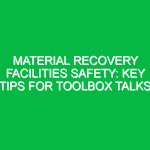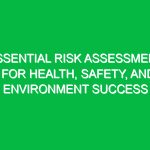Introduction
In the realms of Health, Safety, and Environment (HSE), the term “proper protective equipment” (PPE) is more than just a jargon-filled phrase; it embodies the very foundation of Workplace Safety and risk mitigation. Proper protective equipment refers to devices or garments worn by individuals to protect against workplace Hazards that can cause injury or illness. The importance of PPE cannot be overstated, as it plays a pivotal role in safeguarding employees from a myriad of risks including chemical exposure, physical injuries, biological Hazards, and environmental threats.
Imagine a construction site bustling with activity, where the sound of heavy machinery fills the air. In the midst of this chaos, an employee equipped with high-visibility clothing, hard hats, and steel-toed boots stands confidently, fully aware that the proper protective equipment is doing its part to shield them from potential dangers. This example illustrates the essence of PPE in HSE settings—a protective barrier that not only enhances physical Safety but also instills a sense of security in workers.
As we delve deeper into the essential components of proper protective equipment, this article will explore its significance, best practices, and the critical Regulations that govern its use.
The Core Components of Proper Protective Equipment
Understanding the various types of proper protective equipment is crucial for anyone involved in HSE. Each category is designed to address specific hazards. Here’s a closer look at the key components of PPE:
1. Head Protection
Hard hats are the most common form of head protection. They are vital in environments where there is a risk of falling objects or head impact. Hard hats come in various styles, designed for different types of hazards, including electrical and impact risks. For instance, a hard hat with a chin strap is often advisable in scenarios where workers are elevated, ensuring that it remains securely in place despite movement or wind.
2. Eye and Face Protection
Safety glasses, goggles, and face shields are essential for protecting against chemical splashes, flying debris, and harmful radiation. In industries like manufacturing or construction, where workers are frequently exposed to hazardous materials, the right Eye Protection can prevent serious injuries. It’s also important to choose eyewear that fits properly and is free from scratches to ensure optimal visibility.
3. Hearing Protection
Exposure to high noise levels can lead to permanent hearing loss. Earplugs and earmuffs are the two main types of hearing protection. In environments such as factories or airports, where noise levels can exceed safe limits, the consistent use of hearing protection is essential. It’s crucial to select the appropriate type based on the noise level and the duration of exposure.
4. Respiratory Protection
Respirators and masks are indispensable when dealing with airborne contaminants like dust, fumes, or chemicals. The selection of respiratory protection depends on the specific type of hazard present. For example, N95 respirators are commonly used in healthcare settings to filter out particulates, while full-face respirators provide a greater level of protection for hazardous chemical exposure.
5. Hand Protection
Gloves are perhaps one of the most varied forms of PPE, designed to protect against cuts, abrasions, chemical Burns, and temperature extremes. The choice of gloves should align with the nature of the task; for example, latex gloves are suitable for medical tasks, while cut-resistant gloves are vital in manufacturing or construction.
6. Foot Protection
Safety footwear, including steel-toed boots, is crucial in protecting the feet from heavy objects, sharp materials, and Electrical Hazards. Slip-resistant soles are also an important feature, especially in wet or oily environments.
7. Body Protection
This category includes items such as coveralls, aprons, and vests designed to protect the body from various hazards. For instance, chemical-resistant suits are essential for workers handling hazardous substances, while high-visibility vests are critical in environments with vehicular traffic.
Benefits of Proper Protective Equipment
Investing in proper protective equipment yields significant Benefits for both employees and employers. Here are some of the key advantages:
1. Reduced Workplace Injuries
The primary benefit of PPE is the reduction of workplace injuries and illnesses. By using appropriate protective gear, employees minimize the risk of accidents, which can lead to lost workdays and increased healthcare costs.
2. Enhanced Employee Morale
When employees feel safe, their morale improves. A well-protected workforce is likely to be more productive and engaged. Companies that prioritize Safety through proper PPE foster a culture of care and responsibility.
3. Compliance with Regulations
Adhering to PPE regulations not only protects employees but also helps organizations avoid penalties and legal issues. Compliance demonstrates a commitment to Workplace Safety, which can enhance a company’s reputation.
4. Long-term Cost Savings
While purchasing PPE may require an upfront investment, it can lead to long-term cost savings by reducing incidents and associated costs. Organizations may also benefit from lower insurance premiums due to fewer claims.
Best Practices for Implementing Proper Protective Equipment
To effectively integrate proper protective equipment into the workplace, consider the following Best Practices:
1. Conduct Risk Assessments
Regular risk assessments help identify potential hazards in the workplace. This process should involve evaluating tasks, materials, and environments to determine the appropriate PPE needed.
2. Provide Training and Education
Employees must be trained not only on how to use PPE but also on why it is essential. Ongoing education about the risks associated with their tasks can help reinforce the importance of using protective equipment correctly.
3. Ensure Proper Fit and Maintenance
PPE should fit properly to provide adequate protection. Employers should ensure that all equipment is maintained and replaced as needed. Regular inspections can help identify worn-out gear that may no longer provide adequate protection.
4. Foster a Safety Culture
A workplace culture that prioritizes safety encourages employees to take their protective gear seriously. Leadership should model safe behaviors and recognize employees who consistently adhere to safety protocols.
Potential Hazards and Risks Related to Improper Use of PPE
While proper protective equipment is crucial, improper use can lead to serious consequences. Here are some risks associated with inadequate PPE:
1. Increased Risk of Injuries
Failure to wear the appropriate PPE can result in injuries that could have been avoided. For example, not using hard hats on a construction site can lead to traumatic head injuries from falling objects.
2. Health Complications
Inadequate respiratory protection can expose workers to harmful substances, leading to chronic health issues. For instance, workers in industries dealing with asbestos without proper respiratory gear are at risk of developing serious respiratory diseases.
3. Legal Repercussions
Organizations can face legal actions and fines if they fail to provide adequate PPE or if employees ignore safety protocols. This can lead to financial losses and damage to the company’s reputation.
Regulations and Standards Governing Proper Protective Equipment
Numerous regulations dictate the use of proper protective equipment in various industries. Familiarity with these regulations is essential for compliance and safety. Some of the notable regulations include:
1. OSHA Standards
The Occupational Safety and Health Administration (osha) sets and enforces standards for Workplace Safety in the U.S. OSHA requires employers to provide appropriate PPE for their workers, depending on the hazards present.
2. ANSI Standards
The American National Standards Institute (ANSI) establishes safety standards for various Types of PPE, including eye and face protection, hearing protection, and respiratory protection. Compliance with ANSI standards ensures that PPE meets specific safety criteria.
3. International Standards
Globally, standards such as ISO 9001 for quality management systems and ISO 45001 for Occupational Health and safety management help organizations maintain compliance with international safety regulations.
Conclusion
In conclusion, the significance of proper protective equipment in the HSE domain cannot be overstated. By safeguarding employees against numerous hazards, PPE not only promotes health and safety but also enhances overall workplace morale and productivity.
Employers must commit to understanding and implementing the right protective measures, emphasizing training, compliance with regulations, and fostering a culture of safety. As we continue to navigate increasingly complex work environments, the importance of proper protective equipment will remain a cornerstone of effective health, safety, and environmental management. Embracing these principles will unlock the secrets to a safer workplace, ultimately benefiting everyone involved.


